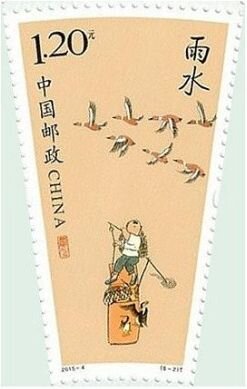Stamp: Rain Water (Fisherman and Birds) (6-2) (China, People's Republic 2015)
Rain Water (Fisherman and Birds) (6-2) (China, People's Republic 2015)
04 February (China, People's Republic ) within release 24 Seasonal Periods (Series I) - Spring (2015) goes into circulation Stamp Rain Water (Fisherman and Birds) (6-2) face value 1.20 Chinese renminbi yuan
| Stamp Rain Water (Fisherman and Birds) (6-2) in catalogues | |
|---|---|
| Michel: | Mi: CN 4652 |
| Stamp Number: | Sn: CN 4256b |
| Stanley Gibbons: | Sg: CN 5949 |
Stamp is square format.
Stamp from se-tenant strip of sixAlso in the issue 24 Seasonal Periods (Series I) - Spring (2015):
- Stamp - Beginning of Spring (Children and Flowers) (6-1) face value 1.20;
- Stamp - Grain Rain (Women Tending to Vegetables on Rack,Rabbits;6-6) face value 1.20;
- Stamp - Pure Brightness (Kite Flying) (6-5) face value 1.20;
- Stamp - Rain Water (Fisherman and Birds) (6-2) face value 1.20;
- Stamp - Spring Equinox (Boy on Bull) (6-4) face value 1.20;
- Stamp - Waking of Insects (Cowherd and Bulls) (6-3) face value 1.20;
Stamp Rain Water (Fisherman and Birds) (6-2) it reflects the thematic directions:
Birds (Aves), a subgroup of Reptiles, are the last living examples of Dinosaurs. They are a group of endothermic vertebrates, characterised by feathers, toothless beaked jaws, the laying of hard-shelled eggs, a high metabolic rate, a four-chambered heart, and a strong yet lightweight skeleton. Birds live worldwide and range in size from the 5 cm (2 in) bee hummingbird to the 2.75 m (9 ft) ostrich. They rank as the class of tetrapods with the most living species, at approximately ten thousand, with more than half of these being passerines, sometimes known as perching birds. Birds are the closest living relatives of crocodilians.
Spring, also known as springtime, is one of the four temperate seasons, succeeding winter and preceding summer. There are various technical definitions of spring, but local usage of the term varies according to local climate, cultures and customs. When it is spring in the Northern Hemisphere, it is autumn in the Southern Hemisphere and vice versa. At the spring (or vernal) equinox, days and nights are approximately twelve hours long, with daytime length increasing and nighttime length decreasing as the season progresses until the Summer Solstice in June (Northern Hemisphere) and December (Southern Hemisphere).


